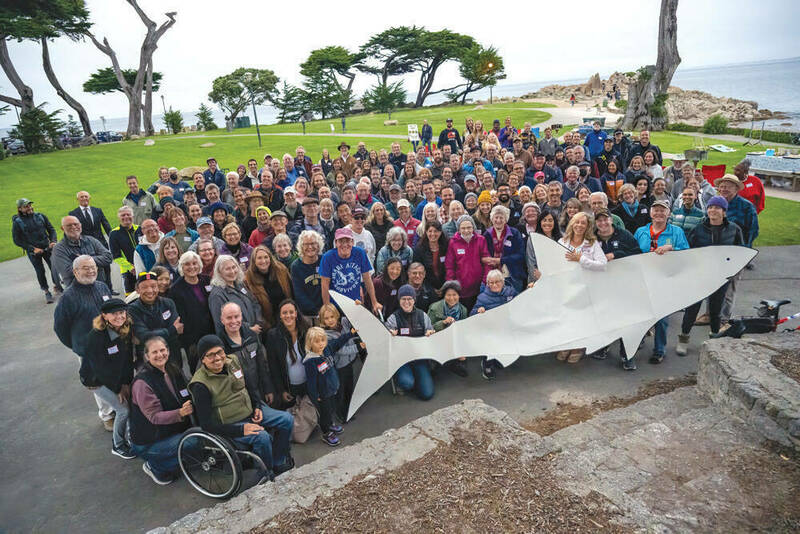 Bruemmer and his wife gathered 200 community members and friends, along with first responders and medical personnel, to thank them for supporting his recovery. Photos provided
Bruemmer and his wife gathered 200 community members and friends, along with first responders and medical personnel, to thank them for supporting his recovery. Photos provided
Midmorning on a quiet Wednesday last June, Steve Bruemmer ’82 was completing a solo swim in the ocean near his home in Monterey, California. The sun was shining, and the Pacific Ocean was unusually clear and calm.
Bruemmer, 62, a retiree, often met friends on the beach at Lovers Point for a morning group swim. That day, he was the only one who showed, so he proceeded on his own.
He swam about a mile and a half and was nearly finished — about 150 yards from shore — when it happened: A great white shark attacked Bruemmer from below, unseen, in water about 20 feet deep. Bruemmer was thrown into the air, then pulled about five feet below the surface.
He was wearing a wetsuit and swim goggles. Underwater, he faced the shark’s enormous head, an arm’s length from one large black eye and its sharp triangular teeth.
“He was looking at me,” Bruemmer says.
Great whites, which can grow up to 21 feet long, have massive jaws with coarsely serrated teeth. Adult sharks usually feed on seals, sea turtles, dolphins and other sea life. Bitten across the thighs and abdomen, Bruemmer thinks the shark mistook him for a seal.
Although he felt no immediate pain, he knew he was seriously injured and needed to get away before the shark continued the attack. “I reached out and pushed his lower jaw with my finger, then I kind of kicked it,” he says.
The predator swam away.

Bruemmer estimates he was underwater for about 12 seconds before he resurfaced, keeping his legs and knees close to his body. He realized his left arm was badly cut. “There was so much blood” in the water, he recalls. “And I could feel my abdomen was badly hurt.”
Surfacing, he yelled for help, and he got it. A married couple, who happened to be a nurse and a police officer, were paddleboarding about 300 yards away and responded immediately.
Beachgoers also reacted. A skilled surfer paddled out with an extra surfboard, helping the husband-wife team move Bruemmer onto the board and paddle him to shore. “They were clearly risking their lives for a stranger,” he says.
No one knew if the shark was still nearby.
A physician and two intensive care nurses were also on the beach that day. They turned t-shirts into tourniquets that they applied to stanch the bleeding as soon as Bruemmer came ashore.
Within three minutes an ambulance arrived and rushed Bruemmer to a trauma center, where he underwent surgery and received 28 units of blood, which saved his life.
He suffered no organ damage, but his injuries were extensive. He spent a day in the intensive care unit and three weeks in the hospital.
Blood donors are Good Samaritans — heroes without whom the system doesn’t work, says Bruemmer, who’s inspired to be a regular donor going forward. “It’s an outstanding example of ‘love your neighbor,’” he says.
More than a decade ago, Bruemmer started competing in triathlons. At the time of the attack, he was in excellent physical shape, which doctors say helped him survive.
Weeks of hospital care atrophied his legs. He spent two months getting around mostly in a wheelchair.
Eventually, he graduated to using a rollator, a four-wheeled walker with brakes and a seat. Though he was determined to walk on his own within a few months, his recovery hasn’t progressed as rapidly as hoped. Over the winter he learned that some of the nerve damage in his legs may be permanent.
“I can walk around my house without the walker, as long as I don’t bend my legs too much,” he says. “If I trip, I can’t catch myself.” Still, he’s worked up to walking about 1.5 miles with the rollator before his legs tell him to rest. He’s coming to terms with the fact that he may always rely on the walker outside his home.
Bruemmer has returned to Lovers Point, a popular beach in Pacific Grove that he still considers lovely and inspiring. When he feels discouraged, he thinks of close friends and relatives who have faced greater health challenges. “I have good role models,” he says.
His wife, Brita, and their two adult daughters, Alice ’20 and Rebecca, have supported him throughout the ordeal. Notre Dame classmates and other friends have reached out with encouragement.
Breummer isn’t putting his future on hold or feeling sorry for himself. He swims, mostly using his arms, three times a week in a pool and does strength training twice a week at a nearby community college. Recently he started tutoring children via Zoom through a local church program. And he’s notified the Monterey Bay Aquarium that he’s ready to resume his longtime commitment as a volunteer.
“I’m pivoting,” he says, “toward living the rest of my life.”
Margaret Fosmoe is an associate editor of this magazine. Contact her at mfosmoe@nd.edu or @mfosmoe.